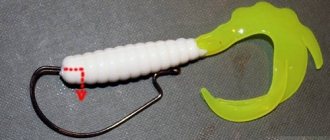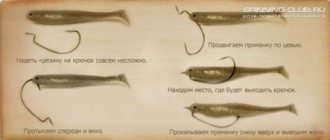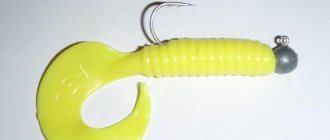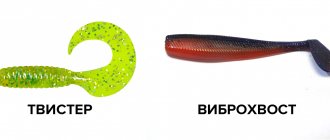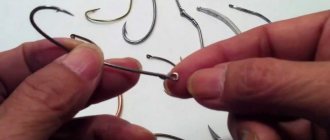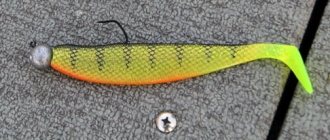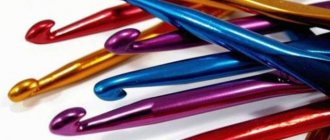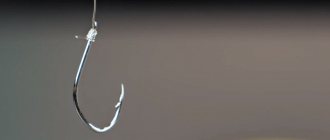An offset hook is a single hook of a special curved shape, designed for use with soft silicone baits. It is used in spinning rods, less often in other fishing directions. This is a sought-after element of gear for a modern fisherman, the correct choice of which determines the result of fishing.
In the proposed material, we will consider how to put the bait on an offset hook, how to choose the optimal offset for silicone and the varieties of these single hooks, how to then mount the equipment and tie it to the main fishing line.
Application area of offset hooks
The offset fishing rod was invented by American fishermen who enjoy fishing for largemouth bass. There it is mainly used in spaced rigs: Carolina, Texas, split shot, weckie, drop shot and others. It allows you to effectively fish in difficult places:
- snag;
- rocky bottom;
- thickets of aquatic vegetation.
In our realities, domestic spinning anglers use an offset hook not only in spaced rigs. With its help, classic jig rigs are mounted on an eared sinker and used in combined baits, increasing their maneuverability and the possibility of hunting in strong places.
Fishing with an offset hook allows you to minimize the number of hooks. In the current difficult economic situation, it makes it possible to reduce the cost of the fishing process while preserving the bait. Now the angler has the opportunity to fish where previously it was impossible to place a spoon or “rubber”.
The advantages of offset hook are:
- A special design that ensures that the equipment does not snag when installed correctly.
- A wide range of shapes and sizes for various baits and diverse fishing methods.
- High strength and reliability.
- With some experience, it is very easy to learn how to properly attach a silicone bait to an offset hook.
One of the disadvantages is that the silicone often slips, and after a bite it can tear where the sting comes out. It is necessary to constantly look at the integrity of the equipment, make sure that the bait does not fly off during a force cast or a sharp grip of a predator.
Advantages
When fishing on small rivers, you can easily throw the “amnihook” even to bushes or into the grass growing on opposite banks. And then, without the risk of snagging, smoothly drag the bait, placing it in the most promising places. The shape of the blades that the master suggested makes it possible to start the wobbler with half a turn.
Thanks to its low profile, it is also remarkable in that it maintains the necessary vertical position even in strong currents.
Silicone fish also work well with the presented equipment. And in order to equip a silicone fish with a blade, you first need to remove the tail plate, because she will interrupt the game. Then the body of the fish needs to be pierced according to a similar pattern as a polyurethane foam fish. If necessary, the hook can be equipped with rubber pieces to strengthen the position during power casts.
As a “bonus,” Dmitry tells how to make a particularly catchy chub crank from silicone baits, and for fly fishing fans, in addition, about rigging the bait with a fluffy tail.
In addition to its functional qualities, offset also has the most affordable cost.
Tips for choosing offset hooks
It is important for a novice spinning fisherman to understand how to choose an offset hook, what to look for, their main characteristics and parameters. The most important indicators of these specialized singles are:
- size;
- form;
- material;
- manufacturer.
The sizes of offset hooks are usually divided by numbers. Offset hooks with the designation “6/0”, “5/0”, “4/0” and so on are large hooks designed for large bulky baits and weighty fish. Single rods marked “6”, “8”, “10” are intended for ultralight, microjig, fishing for white predator and perch.
Advice! Each manufacturer's size range of hooks may differ, but the principle of indicating their length remains the same. The dimensions of offset hooks in centimeters, as a rule, are not indicated.
The shape of offset hooks can be different and are intended for diverse tasks, fishing methods and types of silicone baits. The most common are:
- Classic with straight bend. Used in Texas rigs, Carolina rigs, and jig rigs.
- With a wide bend. It's called "WideGap". This is an offset hook for vibrating tail and other fleshy, bulky baits. Some spinning anglers call these types of offset hooks for pike.
- With an elongated bend. Suitable for twisters and worms.
- With a crescent-shaped bend. It's called "SickleHook". Designed for weighted mounting of silicone baits and fishing at ultra-long distances.
- Models with a weight rigidly attached to the offset forend. Needed for short fishing at shallow depths. Suitable for fishing shallow water areas with algae and coastal strips.
There are offset hooks with a spring designed to securely fix the bait. This option allows you to extend the life of the “rubber”, since with this installation the head part of the bait does not break so quickly, maintaining a suitable appearance for a long time.
All offset machines are made of stainless steel. This material has sufficient strength, rigidity and reliability. Depending on the purpose, it can be subject to various heat treatments, which impart the necessary properties to the product. At the finish, single strips are sprayed. They can be plated with nickel, anodized aluminum, or bronze. The best offset hooks are treated with titanium nitride.
Among the manufacturers of offset hooks there are famous brands known to all fishermen. These are Decoy, Owner, Gamakatsu, VMC. There are products that are cheaper, but of acceptable quality - Mustad, Hayabusa, Select, DAM and others.
How to choose an offset hook for a silicone bait? What should you pay attention to initially? — This is the size of a single. You need to understand how to choose an offset according to the size of the bait. To do this, you need to attach it to the “rubber”. The length of the hook should be approximately equal to 2/3 of the length of the silicone, and the sting should come out in the middle of the bait.
Selection of offset hooks
Not all offsets are created equal. Each manufacturer produces several diverse models that differ in purpose and have certain design features. Offset hooks can be classified according to the following indicators:
- size;
- form;
- material.
Manufacturers of fishing gear do not usually indicate dimensions in centimeters or other quantities. There is a certain generally accepted numbering of offsets. Hooks marked with the numbers “5/0”, “4/0”, “3/0” are intended for heavy trophies and large baits. In light fishing, products “1”, “2”, “4”, etc. are used. For microjig, offset machines “6”, “8”, “10” are used.
This is how all manufacturers number offsets
It is important to understand that offset hooks of the same number from different manufacturers may differ in size, and significantly. Many beginning spinning players face this situation. However, do not despair; with experience, the fisherman learns to correctly determine by eye the suitability of the offset for a particular bait.
Offset hooks also differ in shape and some design features:
- Most often, offsets of a classic shape with a straight bend are in demand. They can be used in jigs, spaced rigs, with oscillating spoons, etc.;
- With an elongated bend. Created for narrow-bodied long baits - worms, twisters, various creatures. Many manufacturers designate it as “Worm Hook”;
- With a wide bend, allowing you to attach a bait such as a wide-bodied vibrotail. Referred to as "Wide Gap";
- With a special crescent-shaped bend. Designed for heavy jigs and allowing you to attach a bait for ultra-long casts. They're called "Sickle Hook".
Installation of offset hook
It’s not difficult to learn how to put on an offset hook. Any beginner, after several unsuccessful attempts, can then easily correctly attach a silicone bait, regardless of its type. You can attach a vibrotail or twister as follows:
- The bait is pierced in the head part from the end.
- The blanket is pulled completely through, and the “rubber” is fixed on the Z-shaped ledge near the eye of the hook.
- To properly attach the bait, you should attach the offset to the body and figure out where to make a puncture in order to bring the sting out in the middle.
- Now all that remains is to pierce the bait from the belly with a sting and remove it from the back.
That's it, the offset hook is installed on a vibrating tail or other type of bait. There are two options: leave the tip of the sting outside or hide it entirely in the silicone body. Both have their place and are used in different situations.
In very snaggy or overgrown places, it is advisable to hide the sting in the body of the bait. This will allow you to avoid excessively frequent snags when passing through strong locations, where even an offset hook does not always save you. When a predator bites, the “rubber” moves down the fore-end, the sting is released and eats into the fish’s mouth. The disadvantage of this installation option is the low effectiveness when grasping underwater inhabitants. Idle strikes are observed, and derailments are possible.
If fishing conditions allow, then it is better to attach a twister or other soft bait, without hiding the tip of the hook completely into the body. This increases the catchability of the equipment, it is easier to break through the predator’s mouth, there are fewer derailments and unsuccessful hooks.
Some novice spinning enthusiasts have a question about how to attach silicone baits of this type, such as worms, slugs or creatures. In fact, there is no difference with how to put on a twister. The “rubber” is first pierced from the end, then the sting is removed from the back and fixed.
Advice! For elongated, narrow-bodied rubber baits, like worms, it is advisable to use offsets with an elongated fore-end. They are labeled on the packaging as WarmHook.
How to put an offset machine on a wide-bodied vibrotail? It is advisable to use WideGap hooks. They allow you to effectively mount the “rubber” without reducing the catchability of the equipment and without changing the performance of the bait. If there are only classic offsets, then it is advisable to trim the belly of the silicone with scissors. This will slightly modify its operation, but will make it non-clinging.
We figured out how to properly put a silicone bait on an offset hook. Now it remains to consider how to tie the assembled equipment to the leash or the main fishing line.
Manufacturing
Anglers know that classic wobblers have hooks at the bottom, which does not allow them to fully enjoy fishing. The bait often clings to obstacles that exist under water, and it is in such places that predatory fish are in ambush. And Dmitry came up with the idea of creating a wobbler without this drawback, namely, the hook on the bait should be reliably protected.
In the video below, the manufacturer explains in detail how to make a fish template using ordinary scissors, a finished model and polyurethane foam material. The master introduces the audience to how to make a slot for a hook and how to correctly position it in the body of the carved fish. This hook, despite the fact that it is well hidden, is easily pressed when a predator bites.
The degree of depth of the wobbler can be understood by the angle of inclination of the blades, which are fixed on the offset hook. Dmitry has 5 similar modifications. The hook, in the area of the blade, is equipped with additional light-accumulating elements, which serves as an attack point during night fishing. In addition, the offset hook is additionally equipped with rings; you can add weight to them, changing the buoyancy of the bait.
The advantages of an offset wobbler are obvious
How to tie an offset hook?
The resulting offset hook rig can be tied directly to the main cord, fastened with a clasp, or attached to a metal leash. The offset can be attached to the fishing line using Palomar or Clinch knots. The first one is done like this:
- The fishing line or cord is folded in half and threaded through the eye of the offset hook.
- A simple single or double knot is tied.
- Then the offset with bait is threaded into the free loop.
- The knot is tightened and the excess thread is cut off.
The clinch is no less reliable than Palomar. How to do it is described below in brief instructions:
- The free end of the cord is threaded into the offset eyelet.
- We keep a small loop near the eye and make about five to seven turns around the fishing line.
- We put the free end of the thread into a loop.
- Carefully tighten the resulting knot.
That's it, the offset hook is attached, all that remains is to cut off the extra piece of fishing line.
In the case of using a fastener or a metal leash with twisting, nothing changes. You must first tie them to the main fishing line, and then put on the bait mounted on the offset machine. All that remains is to throw the equipment into the water and catch some predatory representative of the ichthyofauna.
You will be interested in: how to properly tie a leash to a fishing line.
Advice from seasoned fishermen
Experienced spinning anglers know some of the subtleties and secrets of using offset hooks, which will help them be used more productively. We will share the most important ones:
- On a clear bottom, it is much more effective to use a double fishing hook or treble hook.
- When fishing for pike perch, it makes sense to use offset hook models made of thin wire. Such single-shots are better able to pierce the bony mouth of a fanged predator. On hooks, they unbend more easily, allowing you to save the bait, and then simply return them to their original position by bending them with your hands.
- For pike and catfish, it is more profitable to use stronger hooks. These predators have enormous strength. The pike behaves aggressively and sharply, and the catfish confidently pushes to the bottom. An offset made of thin wire can bend under such a load.
- When using edible baits, it is advisable to purchase offset machines with a spring for “winding” the silicone. This will extend the life of the already delicate material.
- It is necessary to constantly monitor the sharpness of the hook. Equipment with offset is already not characterized by hooking, but with a blunt tip, the likelihood of slippage or idle hooking increases.
It’s impossible to list all the secrets. Over time, any novice spinning angler begins to understand the intricacies of fishing, as invaluable experience and a wealth of acquired knowledge emerges, allowing one to effectively use offset hooks and lures mounted on them.
Some tips for choosing offsets
Successful fishing with an offset hook is impossible without quality products. Bad or defective offsets can fail you at the most crucial moment. Because of this, you can lose a trophy or bait, and a sure bite may turn out to be empty.
For beginners, we can offer the following tips for choosing offset hooks, which will help you buy only high-quality products:
Features of fishing with soft baits
- It is advisable to purchase offsets only from well-known manufacturers in trusted fishing outlets;
- Particular attention should be paid to the heat treatment of the metal. Poorly hardened hooks will be either too soft or, conversely, brittle;
- The sharpening of the tip should not be in doubt. The presence of marriage is unacceptable;
- The shank of the hook should not have any sagging, drips or other defects;
- The ring for attaching to the fishing line must have a sufficient diameter so that a Cheburashka can be attached to it and it would have a sufficient degree of freedom.
A high-quality hook selected for the size of the bait will never fail on a pond, will allow you to hook and remove a predator, and will not break or unbend under increased loads.
What does an offset hook consist of?
An offset hook or offset hooks (translated from English as “displaced hook”) is one of the types of “barbed” elements of spinning equipment, which has a zigzag-shaped bend in its design, popularly called a “step”.
The main structural purpose of the “step” is the strength of holding the silicone bait on a fishing hook and the non-snaking of the hook when fishing in hard-to-reach places in the reservoir.
An interesting feature of the offset hook is that when using silicone in jig fishing, when it gets into the mouth of a fish, it does not suspect that it is already “on the hook”, thanks to the design uniqueness of this fishing hook.
The offset hook is the result of the inventive activity of one of the US residents, who in the 20th century came up with such a fishing “squiggle” for the purpose of reliably fixing a plastic worm on a hook. Then Texas fishermen put the innovation to use and came up with a classic offset rig called the “Texas” rig.
The original classic shape of the “offset” fishhook was like this
Over time, the equipment for jig fishing has undergone changes and has various modifications, which will be discussed below.
- “a” - the segment from the ring to the step allows you to assess the depth of insertion of the hook into the head of the bait;
- “b” “step” , which determines the possible thickness of the bait’s head;
- “c” “forend” is the straight part on which the size of future production depends. So, for example, for jig fishing in a freshwater body, select a hook with a shorter shank than for sea jigging;
- “g” “hooking” is the part of the bend of the fishing hook that holds the prey after hooking it. Hoods come in various shapes: rounded or angular. The difference is that the angular hook allows the hook to penetrate deeper into the mouth of the prey. A rounded hook is considered more durable;
- “d” “sting” is a sharp part that serves to pierce the lip of prey. The quality of the hook depends on the degree of sharpness of the sting. The design of the sting includes a barb (notch), which ensures a tight grip on part of the fish’s pharynx.
1.1 Hook step shape
The shapes of modern offset hooks come in two types:
- The shape in which the sting fits or fits into a special hole in the bait, provided for by the design features. A step in this shape has a zigzag appearance (see Figure 2)
- The shape is in the form of a step, bent twice at an angle of 90 degrees (see Figure 1).
It is believed that the first option with a Z-shape is reliable in attaching bait.
1.1.1 Forend of offset hook step
When choosing a bait, the length of the shank of the step of the offset hook matters. Silicone worms and bulk baits are easily attached to the elongated part of the hook element.
1.2 Offset hook tip
There are two types of position of this part of the hook in relation to the step:
- at an angle;
- parallel.
The sting, located “at an angle”, is aimed at the back of the bait. The advantage of the angular location of the tip is that the percentage of engagement with unnecessary piles in the reservoir is reduced. Disadvantage : the number of prey bites decreases.
The “parallel tip” is not directed at the corner of the step, but runs parallel. With this arrangement, the chances of a successful bite are many times higher, but the chances of catching something unnecessary in the pond also increase. To install the “non-hook”, fishermen hide the tip in the back of the silicone.
Option 1
Option 2
Offset hooks with a sting shape similar to option 1 are used for voluminous (thick) baits, such as crustaceans, vibrotails, octopuses, etc.
The second type is suitable for thin-bodied silicone baits: twisters, slugs, twintails, worms, thin-bodied vibrotails, etc.
You can read more about such silicone bait as twister here
Find out about the features of the artificial silicone octopus nozzle here
Offset hooks - types and correct installation of baits on an offset hook
Due to my line of work, I have to communicate quite often with different fishermen... And from conversations I am surprised to understand that quite a large number of people still do not know how to properly mount a bait on an offset hook.
It would seem that there is so much talk about offset hooks, so many articles... but if you think about it, I haven’t seen a simple article with photographs on how to properly put a bait on an offset hook.
Offset hooks - a brief theory on offset hooks.
“Ofsetnik” is Russian fishing slang. Derived from the English “offset hook”.
Basically, rubber (silicone baits) - twisters, vibrating tails, etc. - are mounted on offset hooks.
Here is a classic view of a mounted bait on an offset hook (don’t remember, the mounting is incorrect)
The task of the offset hook is to ensure the installation of soft bait in a non-snaking version. That is, it is “unhooked” for baits.
Offsetters have problems with fish detection.
Many people criticize offset hooks:
— Some fishermen DO NOT catch snags, but they don’t catch fish either
In fact, if you mount the offset hook correctly, you will catch the fish “as it should” - you rarely catch snags, but you accurately catch the fish.
Practice - How to properly put rubber on an offset hook
Here are two offset hooks from the same manufacturer. Only the series differ. Can you find the differences?
Well, yes, they differ slightly in size... but in our example this is not significant.
Something else is fundamentally important!
Look at the difference between these offset printers:
Look where the offset hook tip is pointing!
At hook No. 1, the sting points clearly towards the fore-end. And at hook No. 2 it’s a little higher.
And this small difference creates a huge difference in bait installation and hooking!
Look, I took a twister with a thin body and put it on offset machine No. 2:
As you can see, the sting is sticking out!
But the same twister is on hook No. 1
Everything is perfect - the offset hook lies exactly on the body of the twister, without protruding.
So, is offset hook No. 2 wrong?
NO! It's just for a different tire. For twisters and vibrotails with a “higher” body!
Like this:
Remember this difference and you can choose an offset hook for a specific tire in the store.
Step 1: pierce the twister from the end. We insert it inward and bend it at a right angle (marked with a red line).
Why do we make such a bend? We simply follow the (Z-shape) curve of the front segment of the offset hook shank.
It turns out like this:
Step 2: We stretch the twister to the shank of the hook, repeating the Z-shaped bend and pull it towards the “eye”
Step 3. Trying the twister on the hook (actually this should have been done in advance)
We need to understand where it is better to pierce the body of the twister.
The red line indicates the intended puncture site.
BUT! Rubber can be hard or soft.
And by changing the puncture location, we can tighten or loosen the installation of the twister on the offset hook.
It is important!
If the rubber is hard, and if you pull it too hard, it will be difficult for the fish to push through the rubber.
=
Step 4 We pierce the twister.
BUT! We pierce perpendicular to the body of the twister (the direction of the puncture is shown in red)
Why? Just look at how the twister is positioned later and you will understand...
Well, the twister itself is mounted on an offset hook. It's very simple, isn't it?
We check the quality of the offset press installation:
— when running your finger along the body of the twister, it should not catch
— when you apply slight pressure on the body of the twister, it should bend.
Installation errors:
Sticking a hook into the body of the twister is not worth it!
When biting, the twister is pressed. And it should be pressed through, releasing the offset hook tip.
Well, if you want the sting to be hidden in the body of the bait, then you can cut a small groove in the rubber body for the hook.
I don't really like this solution, but many people do it.
By the way, there are also factory-made silicone baits with grooves on the back:
On the subject of piercing, some fishermen make a “non-hook” from a jig head. Like this:
In my opinion, this is complete bullshit.
If the sting is hidden in the body, it will be difficult to detect fish. If the sting sticks out, then it’s not unhooked at all...
Or maybe I don’t understand something... but for proper installation, the body of the bait must be very high.
But if it is high, then its lower part will lie on the hook. So?
Then, when biting, where will the rubber be pressed?
In general, I don’t use it and don’t recommend it.
Should I bend the offset hook or not?
If the silicone bait does not want to be beautifully mounted on the offset hook, then you can bend the offset hook itself (point the tip slightly downwards)
This does not add strength to the offset machine, so I did not advise you to do this
Types of offset hook
Sickle Hook or crescent-shaped offsets were created for mounting jig heads. The difference from other species is the peculiar shape of the hook, made in the likeness of a sickle.
Advantages of this type of fishing hooks:
- reliability of bait attachment;
- holds fish well during fishing;
- self-cuts into the side of the prey's mouth.
Wide Gap – have a wide bend angle, which ensures fastening of solid bait. These hooks are also great for mounting shad type lures with a wide belly. An offset press with a wide bend angle is used with large or hard silicone.
Texas hook is a classic shape that was the first to appear on the fishing market. These fishing hooks have a straight bend. Unfortunately, this design feature of the Texas hook shape limits the angler in the use of some silicone baits. As a rule, narrow-bodied baits are attached to such hooks.
2.1 Loaded offset hook
This is a type of hook that belongs to the wide gap type of hook. Such equipment elements differ in that they have lead on the forend, which serves as a weight. As a rule, they are used in conjunction with jerks or swimbaits. May include installation with Cheburashkas.
A special feature of such loaded fishing hooks is the ability to cast long distances and engage in jig fishing in reservoirs rich in vegetation and shallow areas.
About the features of this hook, its advantages and installation, see the channel “Passion for Fishing”
2.2 Offset hook with spring
The advantage is the convenience and reliability of fixing the silicone. Along with these qualities, the bait will last longer, since on a regular offset hook, after N number of powerful bites, the silicone is damaged and becomes unsuitable for further use.
How to equip a vibrotail with hooks
Date: May 6, 2021 | 273
Modern silicone baits come in a very wide variety of shapes. The oldest, most established and popular is the vibrotail. This is a bait in the shape of the body of a fish or some kind of worm, at the end of which there is an asymmetrical penny. This nickel creates vibrations and oscillations when reeling, which attract fish. It is important not only to select the right vibrotails for certain fishing conditions, but also to properly equip the vibrotail. Let's talk about installing these baits.
The most popular way to equip a vibrotail is with a jig head: a special hook combined with a weight. This is the so-called rigid installation, because the weight is rigidly fixed on the hook.
Attaching a vibrating tail to a jig head is quite simple. We try on the hook to the body of the bait, noting exactly where the hook should come out of the back. Then, we pierce the nose part of the bait with a hook and pull it onto the hook so as to remove the hook from the right place. At first, beginners have incidents with the attachment of silicone baits, intricate shapes come out, but with practice, everything comes.
Equipment on a jig head has the following advantages:
- ease of installation;
- Quite a few snags.
Flaws:
- due to the fact that there is only one hook, it is not always possible to correctly hook the fish, as with a tee;
- not the highest performance in terms of bait flight range, especially if the vibrotail is large;
- wide and heavily sailed.
The next way to equip vibrating tails is hinged mounting. Here a “Cheburashka” sinker is used (usually collapsible), as well as a single, double or triple hook with a long shank. Sometimes, for large vibrotails, it is necessary to lengthen the shank of the hook using wire.
Advantages of hinged installations:
- high casting range;
- high degree of freedom of the vibrating tail;
- more active game.
Flaws:
- you need to carefully select the weight of the weight, because
- Not at any weight will the vibrating tail play normally on a hinged mounting.
If you are fishing in snags, then the vibrotail can be equipped with offset hooks, or in combination with the same “Cheburashka” weight, or with a bullet-shaped sliding weight (the so-called Texas rig).
If the vibrotail has a too high body and it is not convenient to place the offset hook in a classic way, there is no space where the fish could crush the bait, then you can attach the vibrotail to the offset hook, turning it flat. Everything works fine in this position.
So, if we fish in ordinary places that are not too cluttered, then we use vibrating tails on ordinary jig heads. If long casting is required, we use a hinged mounting. If the fish is passive, then you can also try to provoke it with another game of bait, changing the jig head to a joint, or vice versa. If bites follow, but the fish is not detected, does not take confidently and only spoils the vibrotails, we use rigs with doubles or tees, or add an additional double or triple hook to a regular rig with a single hook. If we fish in snags, we use offset hooks.
Share with your friends:
Categories: Lures · Tags: Vibrating tails, Hooks, Installation, Equipment, Silicone
Tips for choosing the size of an offset fishing hook
How to choose the right size hook? First, you need to decide on the size of future production. Secondly, choose the right size of silicone bait, in accordance with its width and type.
When choosing a size, you must be guided by the following rules:
- The length of the hook should not interfere with the play of the rubber.
- If you use an offset that is too long, you can ruin the bait by stretching it, thereby compromising its playing qualities.
- The height of the offset hook should be less than the height of the bait body.
- For sea fishing, you should choose a special hook, the design of which is protected from the characteristics of sea water.
isradag.ru
Application of offset hook
All novice fishermen think about what an offset hook is. “Offset hook” is translated from English as “offset hook”. It has a double curved fore-end and a Z-shape to give the bait a strong hold. This equipment is used for a wide variety of single nozzles. It is considered optimal to use “soft-bodied” baits made of elastic materials.
It’s easy to place bait correctly on an offset jig; even a beginner can learn how to do it. Any fishing activity benefits from the use of this type of equipment. Offset hooks provide the bait with smooth and easy gliding. A predator hiding among snags and algae cannot ignore the natural movement of small fish and is sure to find itself among the catch.
Different types of offset hooks are used mainly for spinning fishing. If you put on the bait correctly, it passes through any underwater thickets without any snags. Proper installation of silicone baits, both rubber and foam, will ensure the output is ideally streamlined and imitates the movement of fish. Popularly, an offset machine is called a non-clinging machine, which indicates its ability to slide unhindered in the thickness of river and lake waters.
The best offset hooks are made from carbon stainless steel. A fishing store salesperson can give advice on choosing the most suitable option in a particular case. When purchasing, you should pay attention to the product number, the presence of a protective coating made of titanium, bronze or nickel, and the type and parameters of the selected bait.
Classification
Offset hooks are classified depending on the degree of bending of the forend, the direction of the Z-step angle, the thickness of the material used and the diameter of the ring. The sizes of offset hooks are different. Each of them is suitable only for a specific bait, which should be purchased at the same time as the equipment.
Offset hooks are divided into the following types:
- Texas Hook (straight bend);
- Wide Gap with a wide bend;
- crescent-shaped Sickle Hook;
- models with lead weights for close-range fishing.
Texas Hook is a classic that appeared on the domestic market in the middle of the last century. A hook with a straight shank and a clearly defined rectangular elbow greatly limits the choice of bait. It is allowed to use only narrow, long-bodied bait with minimal clearance at the bottom. Lures for Texas Hook: twisters, vibrotails, worms, slugs. In this case, the material used to make the bait is of great importance: soft rubber is more effective than elastic latex.
The Wide Gap offset hook has a large bend radius, due to which the bait is attached with a gap between it and the fore-end. When a fish swallows such bait, the gap acts as a lever, providing a reliable hook. This type of bait is used not only for soft baits, but also for hard baits. The model is presented in two modifications, designed for baits of different heights. So, if the point of the hook “looks” into the ring, then such a Wide Gap is suitable for narrow baits. When the sting is directed above the ring, wide and tall soft-bodied nozzles are recommended.
Sickle Hook is used for long distance fishing. The shape of the product resembles a sickle. This model reliably fixes large bait, providing a good casting radius for heavy equipment. When biting, the Sickle Hook provides a deep, stable hook. It is believed that this type of hook is the best for holding fish while landing. In addition, the more active the bite, the stronger they stick into the side cavity of the mouth of the caught fish.
Lead-weighted offset hooks are designed for spinning fishing, but are not recommended for long-distance casting. These models do not require additional weight. They pass through even dense thickets in shallow water well.
Offset hooks provide the bait with a position where the point of the hook is hidden in a recess or deep in the body of the bait. This allows the bait to smoothly pass through snags and aquatic plants, and when biting, guarantees excellent fixation.
fishelovka.com
Practice - How to properly put rubber on an offset hook.
Here are two offset hooks from the same manufacturer. Only the series differ. Can you find the differences?
Well, yes, they differ slightly in size... but in our example this is not significant.
Something else is fundamentally important!
Look at the difference between these offset printers:
Look where the offset hook tip is pointing!
At hook No. 1, the sting points clearly towards the fore-end . And at hook No. 2 it’s a little higher.
And this small difference creates a huge difference in bait installation and hooking!
Look, I took a twister with a thin body and put it on offset machine No. 2:
As you can see, the sting is sticking out!
And no matter how hard you try to lift the twister up, it will still stick out. Which means clinging to snags.
But the same twister is on hook No. 1
Everything is perfect - the offset hook lies exactly on the body of the twister , without protruding.
So, is offset hook No. 2 wrong?
NO! It's just for a different tire. For twisters and vibrotails with a “higher” body!
Like this:
Remember this difference and you can choose an offset hook for a specific tire in the store.
Of course, offset workers have other nuances, such as the bend of the forend, the shape of the hook itself, the width of the eye, the thickness of the wire, etc., but you understand the main subtlety.
Rating of offset hooks
The offset hook is increasingly used by anglers when equipping silicone baits. And more and more of these same baits are being made specifically for equipping on an offset machine. A beginner may have many questions - which brand to choose? What requirements must a hook meet? To do this, we will compile a small rating of popular offset hooks, where the criteria will be: sharpening, some characteristics of the wire, suitability of the eye for installation on a Cheburashka cargo, maneuverability among underwater obstacles and price. Let's take a few common companies that have offset hooks in their assortment. Offset specialists have a purpose not only for classic baits, but also, for example, drop-shots, worms, etc.
| Name | Specialization | Size guide | Wire thickness | Sharpening quality | Quality of materials |
| Saikyo | Offset | 4 | 4 | 5 | 4 |
| Hitfish | Offset | 4 | 3 | 3 | 4 |
| Owner | Offset | 4 | 3 | 5 | 5 |
| Decoy | Offset | 4 | 4 | 5 | 2 |
| Volzhanka | Offset | 1 | 1 | 2 | 3 |
Saikyo
Among the offset hooks from the Japanese company Saikyo there are several series that are perfect for jig fishing. These are BS-2312, BS-2315, BS-2317. Why are they so remarkable that they are placed in first place in our rating? Their shape is such that the tip of the hook always lies tightly on the body of the bait, which increases the “passability”. There are series of thick and thin wire. They have a golden mean between elasticity and extension. They do not fail if a serious opponent bites, and at the same time, they unbend on the hooks, saving your bait. An important factor for consumables, which is a hook, is the price. And in this case it is very democratic.
Hitfish
Hitfish are inexpensive, regular-shaped offsets that are well suited for jig fishing. The company makes about 5 types of hooks suitable for our purposes. There are both reinforced ones, made of thick wire, and thin ones. The serious disadvantages of the thin wire series, called J red light, include the hook point being too long. It bends very quickly on any obstacles, especially stones. Let us highlight the Big Hole series of large-eared “offsetters”. A greater degree of freedom in the hinge sometimes gives the bait a more interesting game. Among the shortcomings, it is worth noting that there were occasionally defective specimens with a blunt tip.
Owner
Third in the ranking are Japanese offset printers Owner . Also, not all hooks from the company’s range are suitable for our purposes; let’s highlight a few: 5109, 5139 and 5140. All, except the first series, are made of fairly thick wire. The diameter of the eye is suitable for wire of any “Cheburashka” weights. Just like the first number in the rating, they unbend only when necessary, saving the bait. With sharpening everything is also fine. The only significant negative is the price. The difference with Saikyo is sometimes 2.5 times.
Decoy
Decoy is another representative of Japanese hooks. We will also consider several series suitable for jig baits. Worm 11, Worm 13 and Worm 17. With Decoy you need to pay attention to the diameter of the eyelet; not all of them have it wide enough for the weight wire to pass freely. It should be noted that the hooks are very sharp, the sharpest in the rating. But apparently you have to pay for this. And the payback is not extension on the toe, but breaking. Moreover, hooks break, both from thin wire and from thick wire. Another disadvantage is the price, it is at the level of the second point in the rating.
Volzhanka
In last place in the ranking are offset hooks under the Russian brand Volzhanka . There is only one series suitable for jig fishing - this is the Offset Worm. The shape is common, even small sizes are made of thick wire - this is a big minus. In terms of price, Volzhanka offsets are similar to the first and second points in the rating. The rings are of sufficient diameter everywhere.
We hope this rating of offset hooks will help you in properly equipping your jig baits, because the effectiveness of hooking and landing fish greatly depends on this.
So, step by step we put the twister on the offset hook:
Step 1 : pierce the twister from the end. We insert it inward and bend it at a right angle (marked with a red line).
Why do we make such a bend? We simply follow the (Z-shape) curve of the front segment of the offset hook shank.
It turns out like this:
Step 2 : We stretch the twister to the shank of the hook, repeating the Z-shaped bend and pull it towards the “eye”
Step 3. Trying the twister on the hook (actually this should have been done in advance)
We need to understand where it is better to pierce the body of the twister.
The red line indicates the intended puncture site.
BUT! Rubber can be hard or soft.
And by changing the puncture location, we can tighten or loosen the installation of the twister on the offset hook.
It is important!
If the rubber is hard, and if you pull it too hard, it will be difficult for the fish to push through the rubber.
And if the rubber is soft, and you put it on without tension, then any touch of the snag threatens to snag.
=
Step 4 We pierce the twister.
BUT! We pierce perpendicular to the body of the twister (the direction of the puncture is shown in red)
Why? Just look at how the twister is positioned later and you will understand...
Well, the twister itself is mounted on an offset hook. It's very simple, isn't it?
We check the quality of the offset press installation:
— when running your finger along the body of the twister, it should not catch
— when you apply slight pressure on the body of the twister, it should bend.
Installation errors:
Sticking a hook into the body of the twister is not worth it!
When biting, the twister is pressed. And it should be pressed through, releasing the offset hook tip.
And if you stick the point of a hook into the body of a twister, will the hook be able to pierce rubber and fish? Is not a fact…
Well, if you want the sting to be hidden in the body of the bait, then you can cut a small groove in the rubber body for the hook.
I don't really like this solution, but many people do it.
By the way, there are also factory-made silicone baits with grooves on the back :
On the subject of piercing, some fishermen make a “non-hook” from a jig head . Like this:
In my opinion, this is complete bullshit.
If the sting is hidden in the body, it will be difficult to detect fish. If the sting sticks out, then it’s not unhooked at all...
And here’s another – the classic shape of offset hooks . But I absolutely don't like:
Or maybe I don’t understand something... but for proper installation, the body of the bait must be very high.
But if it is high, then its lower part will lie on the hook. So?
Then, when biting, where will the rubber be pressed?
In general, I don’t use it and don’t recommend it.
Should I bend the offset hook or not?
If the silicone bait does not want to be beautifully mounted on the offset hook, then you can bend the offset hook itself (point the tip slightly downwards)
This does not add strength to the offset machine, so I did not advise you to do this
